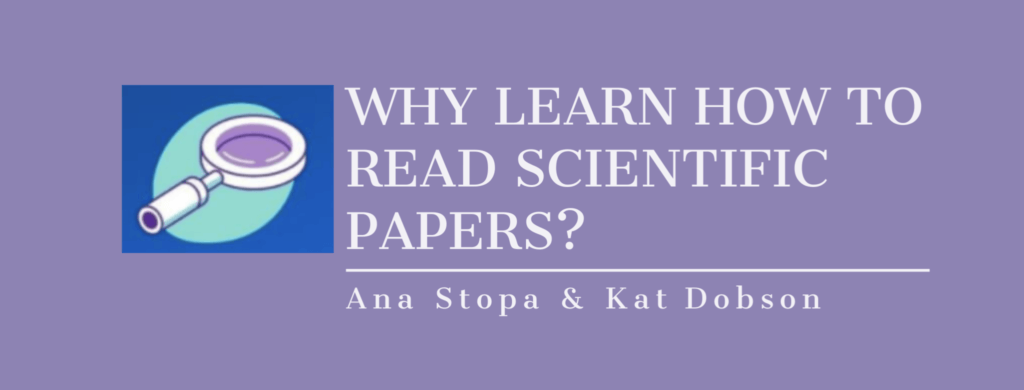In Kyle Shannon’s Towards Data Science’s article, “A Guide to Reading Academic Research”, Shannon emphasizes that reading scientific papers is not just for gathering the right information for a good grade or bragging rights. “Reading papers certainly builds character”, he suggests.
From researcher, to child, to performance athlete, we all have experience in building character through the process of trial and error. This process of personal development is strikingly similar to what high school science experiments were teaching us all along: the scientific method. Much like trial and error, the scientific method attempts to find the best solution through constant revision. We employ this same method when attempting to achieve any goal, and whether that goal is learning to ride a bike or read a research paper, wobbly beginnings should not deter us from the objective. To build character is to try, and fail, and try again because we see value in the outcome. If we viewed science as a kind of global character development, would we be inclined to learn more about it?
Scientific literacy has been defined as, “the knowledge and understanding of scientific concepts and processes required for personal decision making, participation in civic and cultural affairs, and economic productivity” (The National Academies Press, 1996). The misconception that scientific literacy is reserved for scientists puts broader society at a great disadvantage. To be scientifically literate is akin to being able to think critically about yourself and the world around you. Critical thinking precedes thoughtful dialogue, meaningful action, and transformative change.
What is the scientific process?
Reading a scientific paper provides insight into the scientific process. The scientific process involves first posing a question – for example, can psilocybin-assisted therapy help manage symptoms of major depressive disorder? Researchers suggest a hypothesis or a potential answer to the question, one that is based on previously collected knowledge and observations. They design and execute a study to test the hypothesis (for example, by way of a controlled experiment), to either provide evidence for or against the proposed hypothesis. More refined hypotheses may then be created for additional research questions and further experimentation. The scientific process is often non-linear and may never truly reach completion, but a scientific article provides pieces of the process in a cohesive storyline.
Becoming familiar with the scientific process is important, as it strengthens one’s ability to discern factual evidence from false claims. Papers published in many respected journals, such as Science, are subject to a peer-review process. Essentially, before any paper is published, specialists in the field must review and accept the validity of the claims, the methods for testing the claims, and the findings; this acts as a quality assurance check. So, before sharing that news piece or article ask yourself, “Would this pass a peer-review?”
Sections of a scientific paper
Ideally, reading through a scientific paper should not require stages of fear, regret, or rage, so it may be helpful to build a strategy to find information painlessly from each paper section.
Browsing the abstract of a paper should give a snapshot of the entire scientific process, the full story from the question of interest to the conclusion. From the abstract, you should find an outline of the study, main significant findings, and start to build an understanding of why the study is important in the greater context of the field.
If the field is one you are less familiar with or want to know more about, the introduction will give background information and outline what is known to-date. The introduction should narrow down the niche field area for the current study question, outlining why this particular study matters and what knowledge gap it aims to fill.
Now, though the abstract can give an important overview of the study and its outcomes, finer details of the method contextualize what the outcomes actually mean. The outcomes of an experiment, for example, are contingent on the controls and treatments used. The method will outline the exact strategies that were used to produce an answer, including a detailed explanation of the participants, the measures, and the analytic plan for testing hypotheses or research questions. The method section may suggest the limits of research findings. For example, a study may have very exclusive screening criteria, meaning that only participants meeting specific requirements were included in the study, and thus study results may be generalizable only to a population with similar characteristics. Current research in psychedelic science is hopeful but limited by relatively small clinical trials with homogeneous populations.
Results are the critical contribution of the paper. This section is where researchers describe the results of their hypothesis tests. This is where we find the tables and graphs that depict the exact findings of the research.
In the discussion, researchers will interpret the results and identify whether their hypotheses were supported or not, and what the findings contribute to the field under study. Luckily, authors also discuss the potential limitations of the study in this section and further expand upon the relevance of the study in the field. Finally, you can look at references to look for sources to similar studies, but also to check the author’s interpretation of a citation. Readers should also be aware of the acknowledgements section, which may outline conflicts of interest associated with research.
Empowering the psychedelic research community
We are living in extraordinary times, with the re-emergence of psychedelic research unveiling the potential in psychedelic medicine. However, we must move forward cautiously and with the proper intentions. As citizens, we can contribute to this movement simply by re-aligning our own values in favour of science and innovation. If passion is the spark, evidence is the fuel to push you beyond the atmosphere.
While our goal is to disseminate scientific information to our readers, we would also like to emphasize that curiosity and critical thought begins at the individual level. For more tips on understanding the scientific process and related information, check out the links included in this article! As well, stay tuned for more blog posts from our team.

